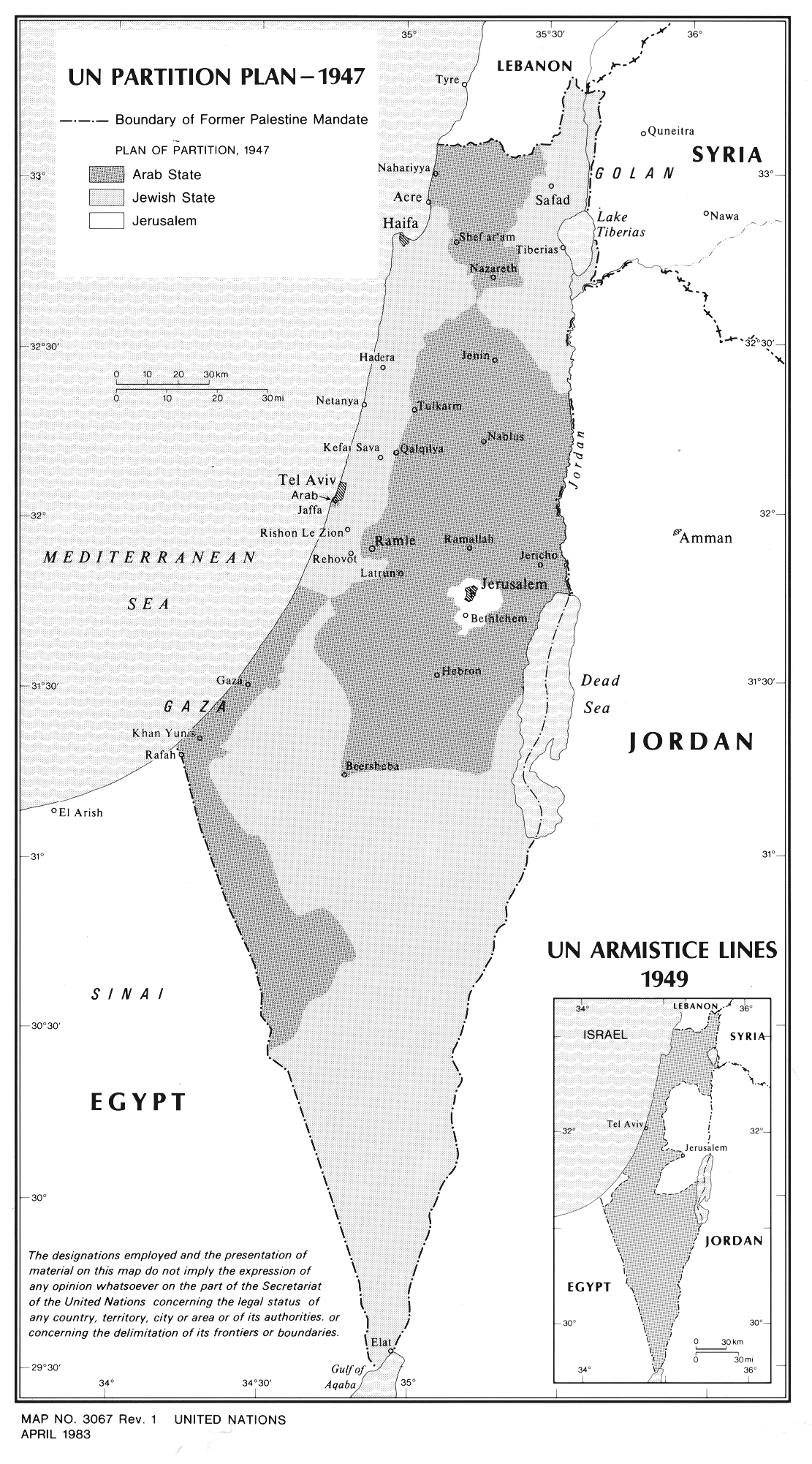For the last 85 years, international officials and diplomats have been advocating for the partition of historical Palestine as the best “solution” to the Zionist-Arab, or Israeli-Palestinian, conflict. Initially proposed by Britain’s Peel Commission in 1937, partition was eventually endorsed by the United Nations in 1947 — first by the Special Committee on Palestine (UNSCOP), and then by the General Assembly. Decades later, and despite the repeated failure to achieve it, a firm international consensus has been built around a modified version of partition now called the “two-state solution,” a paradigm that has remained remarkably resilient to challenge.
Today, however, an increasing number of people between the river and the sea and abroad have started to join a chorus of voices that view partition as impracticable or unjust. Israel is further entrenching its control over the occupied West Bank (the supposed heartlands of a future Palestinian state) by expanding Jewish settlements and infrastructure, all while squeezing Palestinians into ever-shrinking enclaves — a policy that has been applied in severe fashion to the blockaded Gaza Strip.
Against this backdrop, skepticism has grown over whether partition was ever a “solution” in the first place. Historians have shown, for example, that the Zionist leadership’s support for the 1947 partition plan was meant as a tactical maneuver, a stepping stone toward further expansion. Meanwhile, critics of the two-state model as envisioned in the 1990s argue that Israel has merely used the framework as a smokescreen to enable perpetual Jewish hegemony across the whole territory.
Yet none of this explains why partition was proposed, nor how it won and retained such widespread international endorsement. Indeed, Palestine was the only case of settler colonialism outside Europe in which partition became a consensus “solution.” To understand why, and to understand the durability of the idea of partition in Palestine, we need to understand the racial logic that underpins it — a logic that is more complex than is commonly perceived.
As a political “solution,” partition is a framework to resolve (or at least to stabilize) a conflict between somewhat-equivalent parties with competing and incompatible claims over a single territory. This underlying assumption of equivalence is why it was an unlikely framework in settler-colonial contexts, which were typically characterized by a clear racialized hierarchy between settlers and natives.

In the Americas and Australasia, for example, European settler colonialism involved native genocide and incorporation into the new settler states. In Africa, white settlers either left (as in Algeria), or established apartheid regimes whose eventual defeat led to settlers’ incorporation into post-colonial states (as in South Africa).
The list of modern examples of partition includes multinational empires such as Austria-Hungary and the Ottoman Empire following World War I; the partitions of Ireland, Palestine, India, and Cyprus, all in the British imperial sphere; the “ideological” Cold War partitions in Germany, China, Korea, and Vietnam; and more recent partitions, such as Sudan. Palestine is usually regarded as an example of an ethno-national partition (the more common type): a conflict between two ethno-nations, each with valid rights to the territory, which could not be reconciled in a single polity.
But how did the Jewish Yishuv — a society of recent European migrant-settlers — come to be understood as a national group, on par with local Arab Palestinians? And why were Zionists not allowed, at least nominally, outright domination over Palestine, like in South Africa?
A racial matrix
Zionism emerged in Central and Eastern Europe in the late nineteenth century, in the zenith of European imperialist expansion in Asia and Africa. In its discourse and praxis, Zionism was a self-consciously settler-colonial movement; it took pride, as late as 1942, in having “written a notable page in the history of colonization.” This involved, during the British Mandate, the mass immigration of Jews from Europe; a settlement effort throughout Palestine; and the creation of a de facto Jewish autonomy, leading to statehood.
When the Zionist movement won the endorsement of the British Empire (through the 1917 Balfour Declaration) and the League of Nations (as part of the 1922 Mandate), attitudes to colonialism were already changing and turning against the expansion of white colonial settlement. But Zionism was still able to garner international support in that historical moment — not because it was seen as a straightforward European settler enterprise, but precisely because it was not seen as such.

In the dominant European racial thinking of the early 20th century, Jews and Palestinian Arabs were somewhat equivalent and related groups, on the periphery of European whiteness, notwithstanding perceived Jewish developmental advantage over Arabs. Jews were racialized as a Semitic or Oriental people, whose origin was outside Europe — that is, in the historical “Land of Israel.” Therefore, rather than a conflict between European settlers and Arab natives, Britain and the League of Nations saw in Palestine a clash between two national groups: one native to Palestine, the other “re-established” there.
What scholar Saree Makdisi called “Zionism’s bizarre conflation of the discourses of settlement with those of ‘return’” was foundational not only to Zionist self-perception, but also to its international legitimacy. This understanding of Jews as “of Palestine” allowed the inclusion of a settler-colonial project into an international framework of self-determination, in the form of the Mandates system.
As historian Susan Pedersen has shown, the League of Nations took a critical approach to white settlement in the African Mandates of South West Africa (later Namibia) and Tanganyika (later Tanzania). The Permanent Mandates’ Commission also opposed attempts to further expand white settlement and entrench settlers’ privileges. Yet at the same time, these bodies strongly supported the “Jewish national home,” because they did not perceive it as a white settlement project.
This position was further complicated by a racial matrix that placed Arabs and Turks as relatively “advanced” people, still below Europeans but higher than other societies. As such, the Arab Mandates of Syria, Lebanon, and Iraq (“Class A” Mandates) were broadly recognized as ready for provisional independence, unlike former German colonies in sub-Saharan Africa (“Class B”) and the South Pacific (“Class C”). In addition, as members of the “Semitic race,” Europeans assumed there was a racial proximity between Jews and Arabs, even if Ashkenazi Jews were seen as more advanced in developmental terms.
In the spirit of the Balfour Declaration, the terms of Britain’s Palestine Mandate clearly favored Zionism and did not recognize Arab national rights in Palestine (Arabs were not even mentioned by name). But this was not a regime of outright Jewish domination: the British maintained a rhetoric of “dual obligation” toward Jews and Arabs in Palestine — exemplified by the adoption of Hebrew and Arabic as official languages, alongside English.

The assumption of racial equivalence between Jews and Arabs similarly underpinned the Peel Commission Report of 1937, which put forward the first partition plan. In that report, Palestine was formulated as a problem of nationalism and “minorities” to be solved by redrawing borders, creating new states, and transferring populations by force. It was a logic that put Zionism on equal footing with “minority” problems in the Indian subcontinent, Central and Eastern Europe, and the Balkans — not with white settlers in Africa.
While the 1937 plan was rejected, it eventually resurfaced in the UNSCOP proposal for dividing Palestine 10 years later — a plan which followed a similar racial logic, and which continues to provide the framework for the conflict’s resolution to this day.
The impetus for conquest
Seen in this historical light, the Jewish “Return to Zion” was not merely a rhetorical justification or a convenient mythology; it was a racialized structure that simultaneously enabled and constrained Zionism. In the 1930s and 1940s, Zionists were not awarded the hegemonic status enjoyed by white settlers in Algeria and South Africa, but they could still claim national rights and territory. This determined the political horizon of partition.
The failure to take seriously the Zionist ethos and praxis of settlement was one of the main factors behind the failure of partition in the 1940s, and indeed ever since. International advocates of partition believed that Zionism’s main objective was Jewish sovereignty, and believed that Jewish statehood (alongside an Arab state) would meet those aspirations. But the impetus for territorial conquest and settlement expansion proved much stronger.
In the 1948 war, Israel occupied territories well beyond the UN partition plan’s boundaries and incorporated them into the new state. In 1967, Israel occupied the West Bank and Gaza, as well as the Sinai Peninsula and the Golan Heights, and established settlements in all these territories. Even during the heyday of the Oslo negotiations in the 1990s, Israel continued to expand its settlements in the West Bank. Israel remains explicitly committed to Jewish settlement as a “national value,” as enshrined in the 2018 Jewish Nation-State Law. The imperative of colonization and territorial expansion thus renders hollow any talk of partition.

At the same time, the failure to take seriously the enduring legacy of Europe’s racialization of Jews undermines our ability to understand historical and contemporary trajectories of Zionism compared to other forms of settler colonialism. It is true that, at ground level, Zionist colonization followed familiar routes of native dispossession as in many other settler-colonial locales. Yet to insist that Zionism is no different from white settler enterprises in Australia or North America is to misunderstand the racial matrix within which Zionism has operated for more than a century.
The European racialization of Jews, in its antisemitic and genocidal form, drove Jews to Zionism and to Palestine, while simultaneously informing the international legal framework that has facilitated Palestine’s colonization. The lasting power of the partition framework, despite its eight-decade failure as a “solution,” owes much to Europe’s racialization of Jews and Arabs as somehow equivalent and related groups. The understanding of the dynamics in Palestine/Israel as a national conflict, rather than a colonial one, hinges in no small part on the not-quite-whiteness of European Jews.
It is this racial matrix that significantly explains why, despite undisputed Israeli hegemony between the river and the sea, and a clear system of hierarchical domination that has been described by many as apartheid, the dominant international discourse remains one of addressing two nations living “side by side,” rather than of unmaking the colonial relations at the root of the conflict.
This is an adapted summary of an article that was published in ‘Ethnic and Racial Studies’ and is available on open access.

